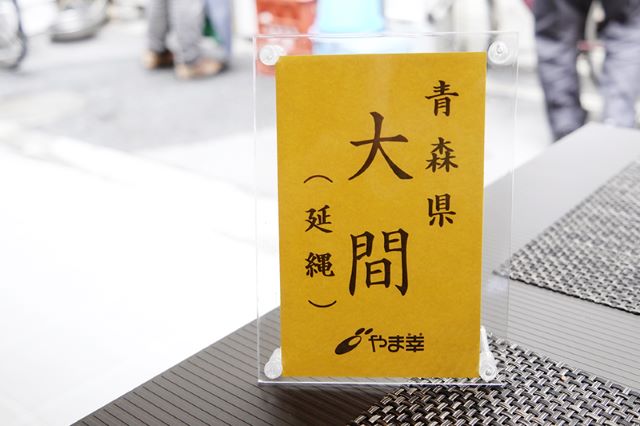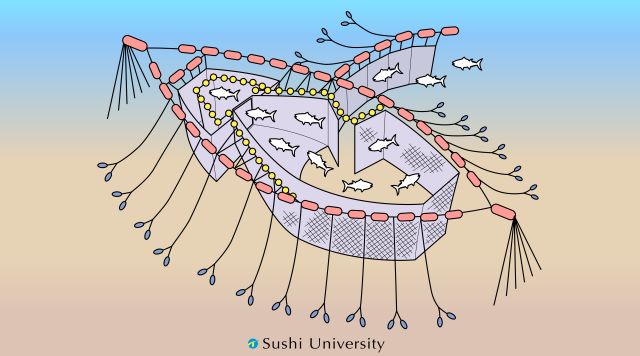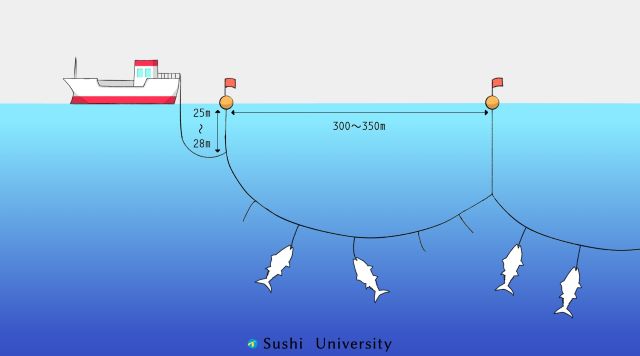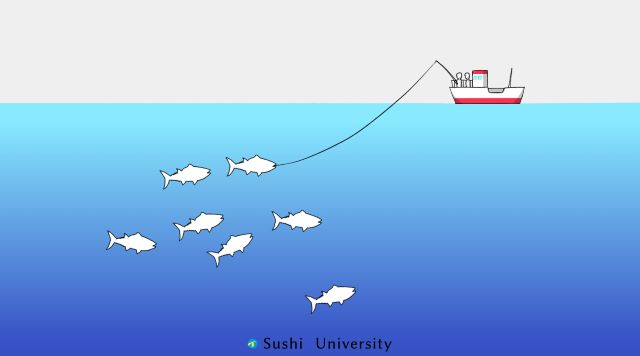When consumers eat fish, they are concerned about whether the fish is fresh or not, but they do not care about the fishing method. Even fishmongers who sell fish face-to-face are not likely to use the fishing method as a selling point.
However, the fishing method is one of the factors that explain why the fish is tasty.
We don’t think there are countries that require information such as the time the fish died or the name of the fisherman who caught the fish, as is the case in Japan. The only information that exists is that the fish was treated with Ikejime immediately after death in order to bring out the Umami.
The reason for Ikejime is to control the amount of inosinic acid, which is the basis of the fish’s flavor, and the timing of its production.
The amount of inosinic acid is inversely proportional to the amount of stress applied when catching the fish, and it is important that the fish die as peacefully as possible. This makes the fishing method used to catch the fish the most important factor. Fishing in such a way that the fish tries desperately to escape is not good because it reduces the amount of inosinic acid produced. In other words, fish caught by fishermen who fish gently are tastier.
The timing for maximizing inosinic acid is then calculated backwards from when the fish dies. Since we want to maximize the inosinic acid at the time the nigiri sushi is served to the customers, we need to buy time for the rigor mortis to begin, which is the preliminary stage. So at places like the Toyosu market, they also treat Ikejime the live fish at a time specified by the sushi chef.

Apart from the name of the wholesaler, there is only the place of origin and the fishing method.
This image shows a delivery note attached to bluefin tuna delivered to a sushi restaurant by a well-known wholesaler at the Toyosu Market. Apart from the name (やま幸) of the wholesaler, there is only the place of origin (青森県大間) and the fishing method (延縄). In other words, you can imagine how important these two items are to the taste of the fish.
We hope you now understand why we are explaining Fishing method. In fact, there are many Fishing methods, but we will explain the Fishing method related to fish used by sushi restaurants. The illustration should help you understand the general situation.
Fixed net fishing (定置網漁)

The fixed-net fishing method is used to catch sardine, horse mackerel, sea bream, yellowtail, and squid. It is highly valued in the market because the fish are not subjected to unnecessary stress, and the quality of the fish is high.
Fixed net fishing involves setting nets in the paths of fish migrating along the coast and catching fish that stray into the nets. The net locations are determined by deciphering the seasonal habits of migrating fish and the currents of the tides. This method mainly catches coastal species such as yellowtail, salmon, sardines, horse mackerel, mackerel, and squid.
It is highly valued in the market because the fish are not subjected to unnecessary stress, and the quality of the fish is high. Its size is more than 50 m wide and 200 m long.
Purse seine fishing (巻き網漁)
Purse seine fishing is a fishing method in which a large net is spread in a circular pattern to quickly encircle a school of swimming fish. Once the school is surrounded by the net, the bottom of the net is squeezed to reduce the size of the enclosure. The target fish are horse mackerel, mackerel, sardines, and other fish that migrate in large schools. It is an efficient method of catching fish, allowing large numbers of fish to be caught at one time.
However, it also leads to the problem of overfishing. It is a growing method of tuna fishing, and is said to be one of the reasons for the decline of tuna resources. At any rate, the parent fish of bluefin tuna just before spawning and Meji-maguro born the previous year are caught in large numbers.
In this method of fishing, the tuna struggle and suffocate to death. Then their body temperature and lactic acid levels rise, causing their flesh to become burnt and their quality to deteriorate. The main source of this problem has been Sakaiminato and other areas, and it has been a problem for some time.
Longline fishing (延縄漁)

Longline fishing is a fishing method for catching fish like Tuna using longline fishing gear.
Longline fishing is a fishing method developed in Japan that uses a long main line to which short branch lines with hooks are attached at regular intervals. The length of the main line can range from several hundred meters to several hundred kilometers. This fishing method is used for tuna, salmon, trout, cod, and flatfish. It has the advantage of selectively catching fully grown fish rather than juveniles by adjusting the size of the fish used as bait. On the other hand, bycatch problems have occurred when other wildlife, such as sea turtles and albatrosses, eat the bait on the branch lines and get caught in the hooks and die, requiring thorough preventive measures. Because it takes so long to pull up the main line, the quality of the flesh of the first fish caught on the hook may have deteriorated.
Pole-and-line fishing (一本釣り)

Pole and line is a fishing method used to catch tuna and other large pelagic species one fish at a time.
Pole-and-line fishing is a fishing method that uses a hook and line to target fish from a fishing boat. It is used for snapper, yellowtail, horse mackerel, mackerel, bonito, and tuna. It is a sustainable fishing method because it does not harm fish as much as net fishing, and it does not catch large numbers of fish at one time.
Fish caught can be processed live or immediately on board, such as Ikejime. In the case of smaller fish such as horse mackerel and mackerel, the fish are not touched when caught but placed in the onboard cage like a divine act. The reason for this is that touching the fish with bare hands causes deterioration of that part of the fish.
This kind of careful handling is carried out until the fish reaches the market. Naturally, the fish can be sold at a higher price because it can be taken to market in good quality. However, fishermen work in small groups on the dangerous sea every day.
Bottom trawling fishing (底引き網漁)
Trawling is one of the most common methods of fishing. Trawl nets are designed to be towed by a boat along the sea floor. Bottom trawling fishing is a method of catching fish (flounder, flatfish, walleye pollock, etc.), shrimp, crabs, and shellfish near the seafloor.
In general, in bottom trawling fishing, nets are cast into the sea and pulled around by fishing boats, which can cause the nets to destroy the seafloor environment, take creatures that are not intended, or damage the seafloor ecosystem.
Fishery management is being attempted by establishing no-take periods and no-take zones, and by improving nets so that they do not catch non-target species.
Share this article